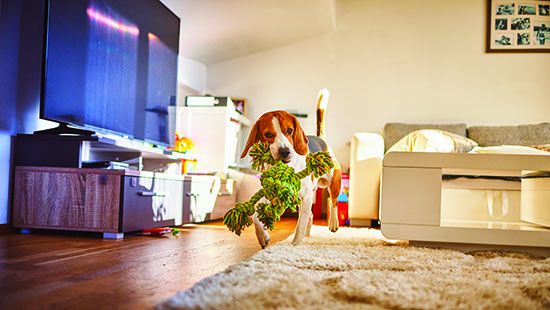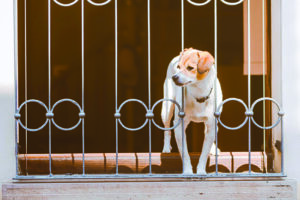
Maintaining a healthy home is in everyone’s best interests. Here are simple steps that can lead to a healthier home environment for you, your dogs, and your family.
NONTOXIC, PET SAFE CLEANERS
In recent years nontoxic household cleaners have become popular in supermarkets, natural food stores, and from online retailers. Some contain traditional ingredients like vinegar and baking soda, both of which you can use individually.
The acetic acid in distilled white vinegar kills harmful bacteria and microbes, plus it has antifungal properties that help resist mold. For a simple all-purpose cleaner, mix equal parts water and vinegar. Apply with a sponge, cloth, or spray bottle, then rinse or wipe with a clean, damp cloth and let dry. Make a spray that can help prevent ant or mite infestations around food storage areas by blending 1 cup distilled vinegar, 1 cup water, and a few drops of peppermint essential oil.
A popular do-it-yourself cleaner for vinyl floors combines 1 cup vinegar, 5 drops baby oil or jojoba oil, and 1 gallon warm water. The result removes waxy buildup and leaves the floor shining.
While recommended for kitchen counters, floors, sinks, mirrors, bathrooms, and windows, vinegar’s acidity can damage stone and should not be applied to granite countertops.
Baking soda, which is alkaline rather than acidic, is an effective scrubbing agent for sinks, countertops, and cookware, plus it’s a natural deodorizer. To remove odors, sprinkle baking soda on carpets before vacuuming and add to laundry wash water.
DUST AND VACUUM
Dust is often a challenge in homes with dogs. If yours is a shedder, you’ll want a good vacuum cleaner, Swiffer floor sweeper, lint rollers, or all three. Vacuum cleaners designed for use around pets feature allergen-capturing filters and attachments that work on floors, furniture, dog beds, and more.
To deal with flea infestations, vacuum areas frequented by your pets every two to three days, especially highly trafficked hallways and paths in your house. Flea eggs, larvae, and pupae can be found wherever a dog lives, and female fleas lay 20 to 50 eggs per day for up to three months. No wonder they’re hard to eliminate!
Flea larvae mature on or near the dog’s bedding and resting areas, so removing opportunities for eggs to develop is the most effective nontoxic flea population control strategy. Don’t forget to vacuum under cushions on couches or chairs that your dog sleeps on. Change vacuum bags frequently and seal their contents safely in a plastic bag (or empty bagless canisters into a plastic bag) before disposing.
HOW TO WASH DOG BEDS
Washing your dog’s bed is a good idea wherever fleas are a problem or whenever it needs a good cleaning, so check bed labels for cleaning instructions. Dog beds, blankets, throw rugs, and removable bed covers can be tossed in the washer with any detergent – you won’t need insecticidal soap, special detergents, or bleach because fleas cannot survive plain water. If desired, add baking soda as a deodorizer.
If a bed cover isn’t removable or the bed shouldn’t be washed, vacuum or clean it thoroughly, scrub it with a damp microfiber cloth, and wash the floor under the bed as often as possible. Purchase several covers, sheets, or towels for pet bed use and rotate them in and out of the wash.
HOW TO CLEAN FOOD AND WATER BOWLS
The best food and water bowls are made of stainless steel. Avoid ceramic bowls, as some decorative ceramics allow chemicals to leach into food and water. Plastic bowls may contain carcinogenic substances and can harbor bacteria.
Washing your dog’s food and water bowls with soap and hot water is especially important if you feed your dog raw meat because pathogenic bacteria can reproduce quickly at room temperature. Your dog should have access to fresh, pure water at all times.
NON-SLIP SURFACES
Slick or slippery floors, whether polished wood, vinyl, laminate, or tile, can pose health risks to dogs who have arthritis or are recovering from an illness or accident. Replace slippery flooring with bamboo or cork, both of which are slip-resistant, or use non-skid rugs, sisal grass runners, peel-and-stick carpet squares, yoga mats, or other skid-free surfaces wherever your dog needs traction.
You can discover a flooring’s slip-resistance by checking for its coefficient of friction, or COF, which is an objective standard of rating how slippery an item is. Manufacturers and retailers publish flooring COF ratings for comparison. Terracotta tile, quarry tile, and brick have high COF ratings, so they are very slip-resistant, while honed natural stone, which is slippery like glass, has one of the lowest COF ratings.

BRING THE OUTDOORS IN
Science tells us that dogs improve human health by bringing the outdoors in, but we don’t want a house full of muddy paw prints. Create an entrance plan to help keep things tidy. A mud room or garage entry, coupled with a super absorbent doormat or rug directly inside or outside the door will reduce incoming dirt. Have a good supply of towels, paw or body wipes, brushes, and grooming supplies nearby to simplify cleanup.
IMPROVE OR PRESERVE AIR QUALITY
You already know that, for your own health, you shouldn’t smoke. But did you know that second-hand smoke has been associated with lung and nasal cancers in smokers’ dogs? If you must smoke, do it outdoors and away from your dog. Don’t smoke in any enclosed space such as a closed room (or worse, in a car) with your dog present.
The air in the average home can be two to 20 times more polluted than the air outside. In addition to using natural cleaning products, open the windows in your home at least once a day unless the outdoor air quality is poor, such as when smog, air pollution, smoke from forest fires, or high pollen counts reduce air quality.
Whole-house and portable air filters remove dust, pollen, mold, and bacteria. Non-toxic houseplants improve air quality by removing carbon dioxide and releasing oxygen. Instead of using chemical “air fresheners,” use scented flowers, dried herbs, or aromatherapy essential oil diffusers to add fragrance.
KEEP YOUR YARD “GREEN”
Pet waste smells bad and can attract flies and spread worms. Removing it daily helps prevent health problems including coprophagia (when dogs eat their own or other dogs’ poop).
In place of commercial pesticides and herbicides, look for safe, organic compounds that can help control garden pests and keep your yard healthy without the use of toxic chemicals.
Every improvement you can make in the health of your home and yard will help your dog avoid common problems.






Nice article😊 informative and well written article 😊😉